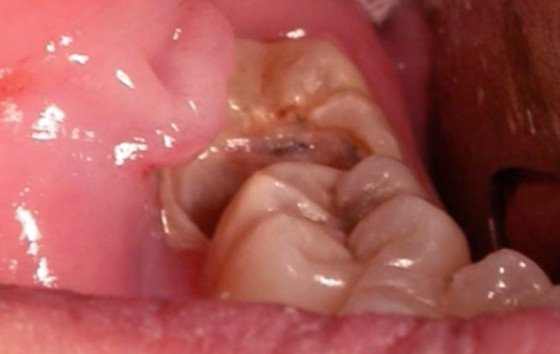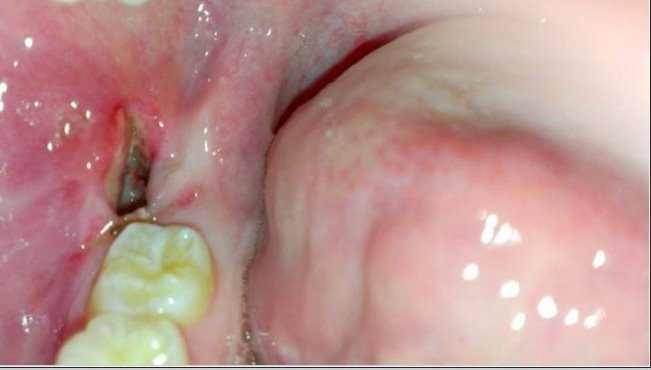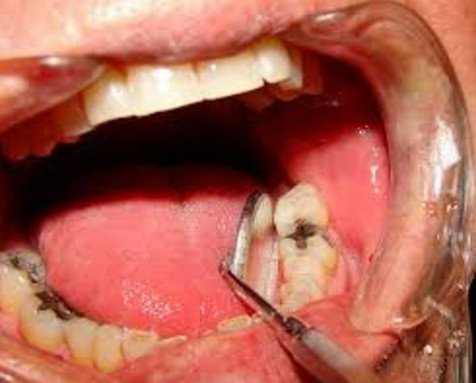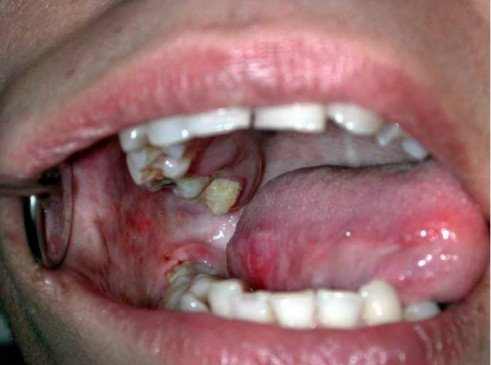A partial eruption of wisdom teeth may affect the configuration of the gum tissue that surrounds it. This position makes it impossible to properly clean the area, which leads to the accumulation of bacteria and food debris, which can finally cause an infection. Having an infected wisdom tooth is an unpleasant condition and usually requires immediate attention. Here are some of the symptoms of an infection and how to clear with home remedies.
Wisdom teeth infected
Your wisdom teeth, also known as third molars, are four permanent teeth found in the very back of the mouth. They usually emerge in people between the age of 17 to 25. When they don’t break through the gums normally, it becomes a problem for the surrounding teeth. Sometimes they grow at odd angles in the direction of an existing tooth, or toward the back of the mouth. A wisdom tooth can partially emerge due to lack of room, and each of these cases is known as an impacted tooth.

A partial eruption of a wisdom tooth can create a flap of gum tissue next to the tooth. The flap can trap bits of food and debris. It can turn into a hotbed for bacteria resulting in an infection in the gum surrounding the wisdom teeth. This is known as pericoronitis, and it has the following symptoms;
- The painful or swollen gum tissue around wisdom teeth
- Swollen lymph nodes
- A foul smell or taste in your mouth
- Spasms in the jaw muscles
Complications associated with wisdom teeth infection
- Tooth decay- also called dental caries, is a condition that develops when plaque begins to break down the surface of your tooth.
- Gingivitis- this occurs when plaque releases toxins that irritate your gums, making them red, swollen, and painful. This condition can also affect the surrounding teeth and the bone around the wisdom teeth.
- Pericoronitis- refers to a bacterial infection located in the soft tissues that surround the crown of a partially erupted tooth, and most cases involve wisdom teeth.
- Abscess- it is when pus collects in your wisdom teeth or the surrounding tissue. The common reason for this is a bacterial infection.
How do you get rid of infected wisdom teeth?
An infected tooth is severe and can be a bit tricky to treat. That’s because when your wisdom teeth don’t come in all the way, a flap of gum will cover where the partial eruption started. Your wisdom tooth infection is unlikely to heal until this flap is removed, your wisdom tooth comes in all the way, or the wisdom tooth is removed.
A dental surgery- since 85 percent of all wisdom teeth need to be removed, many doctors will recommend extraction to prevent further wisdom teeth infection. Your dentist may recommend removing a wisdom tooth if it is causing problems or a procedure to remove the gum flap. This may require a referral to a specialist oral surgeon or maxillofacial surgeon.
Signs of infection
How do you know if you have a wisdom tooth infection?
- Along with the pain, an infected wisdom tooth might also cause sore throats and swollen lymph glands just under the jaw.
- Redness, tenderness, and swelling in the gum tissue immediately surrounding the wisdom tooth
- There can also be moderate to severe pain, an unpleasant mouth odor, and even bad taste coming from the infected area.
Impacted wisdom teeth infection
Impacted wisdom teeth are wisdom teeth that do not fully erupt into the mouth because of blockage from other teeth. If the teeth do not have an open connection to the mouth, pain can develop with the onset of inflammation or infection or damage to the adjacent teeth.
How do you know if you have an impacted wisdom tooth? Before jumping into conclusions about the infection, you should first be sure if it is an impacted tooth. The only way to know if a wisdom tooth that is partially through the gum is impacted is to see a dentist or an oral surgeon for an X-ray. When they are impacted, it means the teeth either become stuck under the gum.
Common symptoms of impacted wisdom teeth include;
- Throbbing pain in the back of the mouth- impacted wisdom teeth causes a great deal of pain, particularly as the condition worsens. You may notice pain radiating from the back of the mouth, particularly focused on the area around the wisdom teeth and other molars. This pain can get worse as the surrounding teeth begin to become affected.
- Swollen, tender, and bleeding gums- impacted wisdom teeth can cause serious gum issues. The gums may become swollen and tender to the touch. They may start to bleed when pressure is applied, making flossing and brushing both painful and difficult. This condition should be notified to the dentists as soon as possible.
- Swelling around jaw- impacted wisdom teeth are often accompanied by swelling of both the gums and jaw. It can be subtle at first but can worsen quickly to the point that it can become painful or difficult to open your mouth.
- Headache- impacted wisdom teeth causes’ pain on the temporomandibular joint which connects the jaw and skull. This pain may radiate to other areas of the head and the face causing a severe headache.
- Swollen glands in the shoulder and neck- swollen glands in the shoulder and neck are symptoms accompanied by impacted wisdom teeth.
Impacted wisdom teeth infection can lead to several complications as the condition worsens. These include;
- Gum disease-impacted teeth are very prone to infection and delay. This can lead to serious issues in the mouth because the back portion of the gums is difficult to clean as is. Therefore bacteria get easily trapped, which leads to further gum disease and tooth decay.
- Cysts- normally, wisdom teeth grow within a sac that is located in the interior of the jaw. These sacs can fill with fluid when the wisdom tooth gets impacted, which can lead to cysts that can damage nerves, causing pain and damage to the adjacent teeth.
- Damage and realignment of adjacent teeth- impacted wisdom teeth can push on the teeth around them, causing infection or forcing the teeth out of place.
Infection after wisdom teeth removal
The removal of wisdom teeth is one of the most common procedures carries out, especially in the UK. The wisdom teeth grow at the back of your gums and are the last teeth to come through. They usually grow through the late teens or early twenties. By this time, the other 28 adult teeth are usually in place, and so there isn’t always enough room in the mouth to grow properly.

Because of the lack of space, the wisdom teeth can sometimes emerge at an angle or get stuck and only partially emerge. Your dentists will check your teeth and advise you on whether they need to be removed. Your wisdom teeth don’t usually need to be removed if they are impacted but aren’t causing any problems.
How is your wisdom tooth removed?
This procedure is carried out by a specialist surgeon. Before the procedure, a local anesthetic injection to numb the area around the tooth.
In some cases, a cut may be needed in your gum, and the tooth may need to be cut into smaller pieces before it’s removed.
This procedure y isn’t painful because the area will be numb. In case you feel any pain, tell your dentist or oral surgeon to give you more anesthetic.
After the removal of a tooth, you may experience swelling, pain, and discomfort, both on the inside and outside your mouth. Your dentist may place gauze over the site of the extraction and ask you to keep the pressure on it by biting your jaws together for up to an hour. This is to allow a blood clot to form in the empty tooth socket. Blood clots are part of the healing process, so try not to dislodge them.
This condition is worse for only 3 days, but it can last up to two weeks. In some cases, antibiotics may be prescribed if you have an ongoing infection. For 24 hours after removing your wisdom tooth, you should not;
- Rinse your mouth out with liquid
- Drink alcohol or smoke
- Drink hot liquids such as tea or soup
- Strenuous physical activity
How to prevent wisdom tooth infection
The treatment for wisdom tooth symptoms depends on the cause. Proper oral hygiene is the key to preventing the symptoms of infection.
1. Don’t smoke
Avoid smoking or using tobacco products when suffering from an infected wisdom tooth, as these activities irritate the gums and can cause or make an infection worse.
- Cigarette smoking is bad for your health in general, and your oral health is no different. You should work on stopping this as soon as possible.
- Smoking can also stain your teeth and tongue, slow your body’s ability to heal, and cause gum disease and oral cancer
2. Regular checkup
Scheduling regular checkups with your dentist is the best preventative measure you can take to avoid wisdom tooth infection and other dental issues.
You should see your dentist every six months, mainly if your wisdom teeth have not yet emerged. Your dentist may recommend that you visit more frequently if you have certain health issues.
3. Use of an antiseptic mouthwash
Using an antiseptic mouthwash helps to control the level of bacteria inside the mouth, while also keeping your breath nice and fresh. Your dentist may recommend that you obtain one with the ADA seal of acceptance; these have been approved by the American Dental Association as effective for your teeth.
- You can use mouthwash before and after brushing. Pour a small cap-full of the mouthwash into your mouth and swish it between the teeth for about 30 seconds before spitting out.
- You can use a commercial brand antiseptic mouthwash, or simply rinse your mouth with undiluted chlorhexidine, which is available in most pharmacies.
What products do we recommend?
4. Brush your teeth regularly
To avoid future infections, it is essential to maintain good oral hygiene. The first step to good oral hygiene is to brush your teeth at least twice a day using a soft-bristled toothbrush.
5. Floss daily
Flossing is just as vital as brushing, as it removes built-up plaque and bacteria from between the teeth that the toothbrush cannot reach. If this plaque isn’t removed, it can cause tooth decay, infection, and gum disease. Do it at least once a day

Home remedies to treat infected wisdom tooth
The infected wisdom tooth is rather uncomfortable and irritation that requires immediate relief. The following are some common home remedies that help to both provide instant relief and cure such a condition
1. Salt
Salt contains anti-inflammatory properties that help in reducing inflammation of the gums. It also has qualities to prevent and fight infection. The following is how you use pain on your infected wisdom tooth;
- Add 1 tablespoon of salt in a cup of warm water
- Swish it in your mouth several times a day to keep the pain and germs away
- You can also mix equal amounts of salt and pepper with a few drops of water to form a paste
- Apply this paste on the affected tooth and leave it for a few minutes
- Follow this remedy 2 to 3 times daily until the pain is gone
2. Garlic
Garlic contains antioxidants, antibiotics, anti-inflammatory, and other medicinal properties that help relieve pain caused by an infected wisdom tooth. It can also slow down or prevent bacterial infections in your mouth. Chew 2 to 3 cloves of garlic to get relief for the pain.
3. Use an ice pack
If you don’t want to take any medications, apply an ice pack on your infected wisdom tooth. It will relieve pain and reduce inflammation. How to apply;
- Pour ice cubes in a plastic bag or a towel.
- Press the bag against the affected area for at least 10 minutes.
- You can also use a bag of frozen vegetables, such as peas or corn.
4. Sage
Sage is a natural pain reliever and very effective in providing instant relief from tooth pain. It also contains antibiotic and anti-inflammatory properties that help cure toothaches as well as gingivitis and bleeding gums.
5. Vanilla extract
Vanilla extract contains low levels of alcohol as well as antioxidant properties that can help numb the pain of a wisdom tooth
How to apply it;
- Apply 3 or 4 drops of vanilla extract onto a cotton swab
- Hold the cotton swab directly against the affected tooth for several minutes
- Repeat this 2 to 3 times until the problem clears
- Note: vanilla extract is not the same as vanilla
6. Clove
Clove contains anesthetic and analgesic properties that help numb pain caused by the infected wisdom tooth. It has been proved that this remedy helps reduce pain as well as other toothaches. It also has antiseptic and antibacterial properties that play a major role in preventing the infection. You can use both clove buds and clove oil. The following is the procedure of applying this remedy;
- Mix 1 crushed garlic clove, a little rock salt and a few drops of clove oil to make a paste
- Apply a thick coat of it on the infected gums and leave it for 5 to 10 minutes
- Rinse it off with warm water
- Repeat this once or twice daily
7. Asafetida
Asafoetida, also known as hing, is an age-old Ayurvedic remedy to alleviate pain of wisdom teeth infection. It also contains anti-inflammatory, antibacterial, antiseptic, and antispasmodic properties.
The following is the procedure of using this remedy of applying this product on infected wisdom teeth;
- Mix ¼ teaspoon of asafetida powder with 2 tablespoons of lemon juice.
- Heat this mixture slightly and then soak a cotton ball in the solution.
- Place it on the infected wisdom tooth.
8. Onion
Onions contain antiseptic, antibacterial, and anti-inflammatory properties that can help relieve toothaches and kill germs that may be able to lead to the infected wisdom tooth. The following is how to use it;
- You can simply chew a few slices of raw onion for a few minutes
- You can also place a small piece of raw onion directly on the affected tooth.
- Do this frequently in a day to help relieve the pain.
9. Guava leaves
Guava leaves are rich in anti-inflammatory, antimicrobial, and analgesic properties that make this product an excellent remedy for relieving toothache. They also have bioflavonoid known as quercetin that has antispasmodic properties.
The following is how to use this remedy;
- Chew tender guava leaves slowly to release their juice into your mouth. This will soon relieve your pain.
- You can also boil 4 to 6 leaves in 1 cup of water for about 5 minutes. Strain the water and allow it to cool. Then use it as a mouthwash 2 times a day to alleviate wisdom tooth pain.
References
- Wisdom tooth removal: http://www.nhs.uk/conditions/Wisdom-tooth-removal/Pages/Introduction.aspx
- Dental health and pericoronitis: http://www.webmd.com/oral-health/guide/pericoronitis
- The symptoms of impacted wisdom teeth: http://www.colgate.com/en/us/oc/oral-health/conditions/wisdom-teeth/article/the-symptoms-of-impacted-wisdom-teeth-0113
- Infected wisdom tooth: http://www.colgate.com/en/us/oc/oral-health/conditions/wisdom-teeth/article/infected-wisdom-tooth-options-0416
- Home remedies for wisdom tooth pain: http://www.top10homeremedies.com/home-remedies/home-remedies-wisdom-tooth-pain.html
- How to deal with an infected wisdom tooth: http://www.wikihow.com/Deal-with-an-Infected-Wisdom-Tooth


